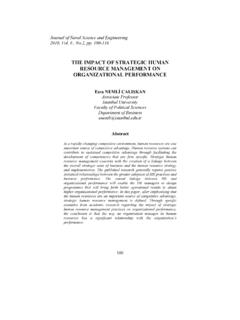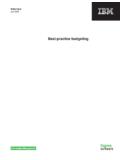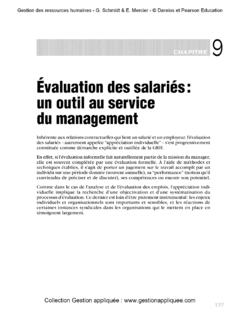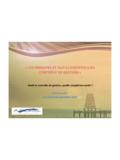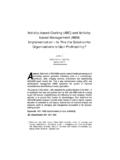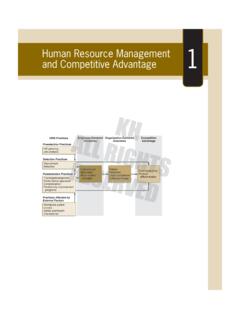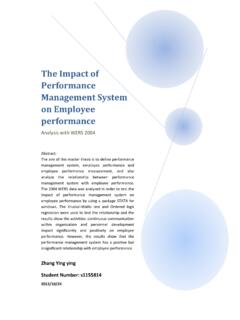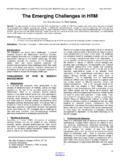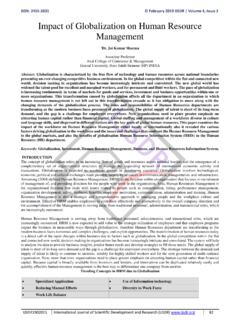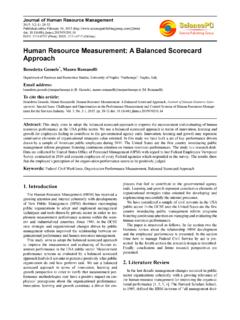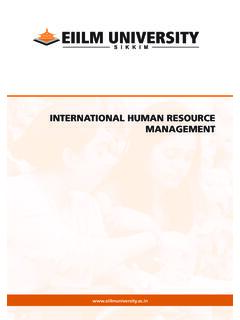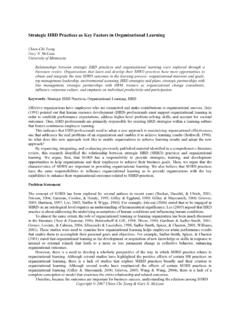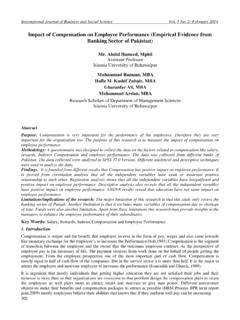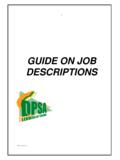Transcription of THE IMPACT OF STRATEGIC HUMAN RESOURCE …
1 Journal of Naval Science and Engineering 2010, Vol. 6 , , pp. 100-116100 THE IMPACT OF STRATEGIC HUMAN RESOURCE management ON ORGANIZATIONAL PERFORMANCEEsra NEML ALI KANA ssociate ProfessorIstanbul UniversityFaculty of Political SciencesDepartment of a rapidly changing competitive environment, HUMAN resources are one important source of competitive advantage. HUMAN RESOURCE systems can contribute to sustained competitive advantage through facilitating the development of competencies that are firm specific. STRATEGIC HUMAN RESOURCE management concerns with the creation of a linkage between the overall STRATEGIC aims of business and the HUMAN RESOURCE strategy and implementation.
2 The published research generally reports positive statistical relationships between the greater adoption of HR practices and business performance. The causal linkage between HR and organizational performance will enable the HR managers to design programmes that will bring forth better operational results to attain higher organizational performance. In this paper, after emphasizing that the HUMAN resources are an important source of competitive advantage, STRATEGIC HUMAN RESOURCE management is defined. Through spesific examples from academic research regarding the IMPACT of STRATEGIC HUMAN RESOURCE management practices on organizational performance, the conclusion is that the way an organization manages its HUMAN resources has a significant relationship with the organization s NEML ALI KAN101 STRATEJ K NSAN KAYNAKLARI Y NET M N N F RMA PERFORMANSINA ETK S zet nsan kaynaklar h zla de i en rekabet evresinde i letmeler i in nemli bir rekabet avantaj kayna d r.
3 Nsan kaynaklar sistemleri firmaya zel yetkinlikler geli tirmek suretiyle s rd r lebilir rekabet avantaj sa lamaktad r. Stratejik insan kaynaklar y netimi firman n stratejik ama lar ile insan kaynaklar stratejisi ve uygulamalar aras nda ili ki kurmaya al maktad r. Firman n insan kaynaklar fonksiyonlar i letme stratejisini ger ekle tirmeye yard mc olacak ekilde d zenlenmelidir. Bu konudaki ara t rmalar genellikle insan kaynaklar uygulamalar ile firma performans aras nda pozitif bir ili ki oldu unu g stermektedir. Bu ili kinin varl insan kaynaklar y netiminin ve y neticilerinin i letmeler i in nemini artt rmakta, insan kaynaklar ile ilgili harcamalar n maliyet olarak g r lmeyip yat r m olarak de erlendirilmesi gere ini ortaya koymaktad r.
4 Bu al mada insan kaynaklar n n i letmeler i in nemli bir rekavet avantaj kayna oldu u vurguland ktan sonra stratejik insan kaynaklar y netimi tan mlanm t r. Akademik ara t rmalardan rnekler verilerek insan kaynaklar y netimi uygulamalar n n firma performans zerinde olumlu etkisi oldu u sonucuna var lm t : HUMAN Resources, Competitive Advantage, STRATEGIC HUMAN RESOURCE management , Organizational PerformanceAnahtar Kelimeler: nsan Kaynaklar , Rekabet Avantaj , Stratejik nsan Kaynaklar Y netimi, irket Performans environment is changing rapidly and this change is characterised by such phenomena as the globalization, changing customer and investor demands, ever-increasing product-market competition.
5 To compete successfully in this environment organizations continually need to improve their performance by reducing costs, innovating products and processes and improving quality, productivity and speed to market. The IMPACT Of STRATEGIC HUMAN RESOURCE management On Organizational Performance102 The people who make up an organization - HUMAN resources- are considered to be one of the most important resources of today s firms. People and how they are managed are becoming more important because many other sources of competitive success are less powerful than they used to. Recognizing that the basis for competitive advantage has changed is essential to develop a different frame of reference for considering issues of HUMAN RESOURCE management and strategy.
6 [1] Traditional sources of success such as product and process technology, protected markets, economies of scale, etc. can still provide competitive leverage but an organization s HUMAN resources are more vital for its sustainability. Parallel to the understanding that HUMAN resources are vital for an organization, HUMAN RESOURCE management function is also going up in organizational hierarchy. HUMAN RESOURCE management aims to ensure that the organization obtains and retains the skilled, committed and well-motivated workforce it needs. This means taking steps to assess and satisfy future people needs and to enhance and develop the inherent capacities of people their contributions, potential and employability by providing learning and continuous development opportunities.
7 It involves the operation of recruitment and selection procedures, management development and training activities linked to the needs of the business.[2] STRATEGIC HUMAN RESOURCE management (SHRM) represents a relatively new transformation in the field of HUMAN RESOURCE management . SHRM is concerned with the role HUMAN RESOURCE management systems play in firm performance, particularly focusing on the alignment of HUMAN resources as a means of gaining competitive advantage. Organizations are becoming aware that successful HUMAN RESOURCE policies and practices may increase performance in different areas such as productivity, quality and financial NEML ALI KAN1032.
8 HUMAN RESOURCES AS A SOURCE OF COMPETITIVE ADVANTAGEThe concept of competitive advantage was formulated by Michael Porter. Competitive advantage, Porter asserts, arises out of a firm creating value for its customers.[3] Porter emphasized the importance of differentiation, which consists of offering a product or service that is perceived industry-wise as being unique , and focus seeing a particular buyer group or product market more effectively or efficiently than competitors who compete more broadly . He then developed his well-known framework of three generic strategies, -cost leadership, differentiation, focus- that organizations can use to gain competitive advantage.
9 Porter s widely accepted view suggests that the industry environmental determinants- affects a firm s performance. RESOURCE -based view, on the other hand, asserts that the basis for a competitive advantage of a firm lies primarily in the application of the bundle of valuable resources at the firm's disposal.[4] Competitive advantage, according to this view differs from the environmentally focused STRATEGIC management paradigm in that its emphasis is on the links between the internal resources of the firm, its strategy and its performance. The RESOURCE -based view suggests that HUMAN RESOURCE systems can contribute to sustained competitive advantage through facilitating the development of competencies that are firm specific.
10 [5] The sustained superior performance of many companies has been attributed to unique capabilities for managing HUMAN resources to gain competitive advantage. Conversely, to the extent that HR systems inhibit the mobilization of new competencies and/or destroy existing competencies, they may contribute to organizational vulnerability and competitive disadvantage. In the closing years of the twentieth century, management has come to accept that people, not products, markets, cash, buildings, or equipment, are the critical differentiators of a business enterprise. All the assets of an organization, other than people, are inert.
